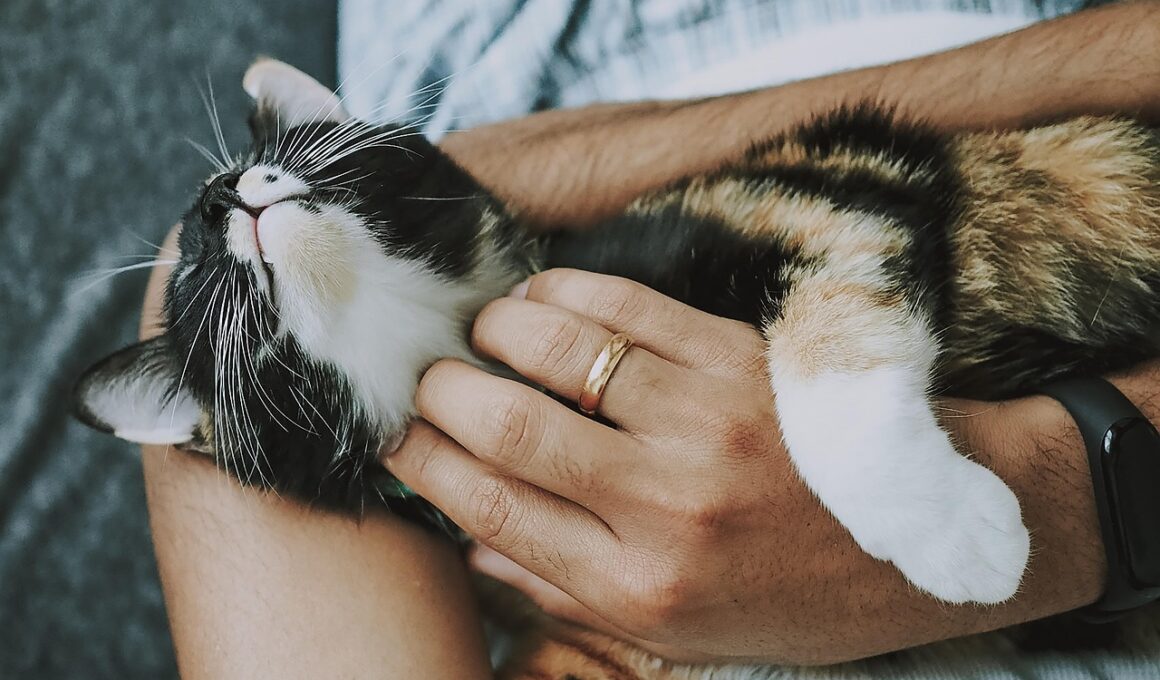Effective Oral Pain Management Techniques for Cats
Cats are prone to various dental issues that can lead to significant oral pain and discomfort. Identifying pain in your feline friend can be challenging since cats often mask their discomfort. It’s essential to monitor their behavior, look for subtle changes, and take action when needed. Regularly scheduled veterinary check-ups, at least once a year, are key to detecting dental disease early. A veterinarian can conduct a thorough oral examination and recommend the necessary treatments. Understanding the signs of oral pain can also help you address issues before they escalate into severe problems. If your cat is experiencing difficulty eating, increased irritability, or frequent grooming of their mouth, it may indicate dental pain. Additionally, bad breath and excessive drooling can be signs you should not ignore. Look for physical signs like swollen gums or broken teeth. Consulting your veterinarian about appropriate pain management options is vital if you notice any discomfort. Always prioritize your cat’s health and wellbeing to keep their dental health in check, avoiding serious conditions. Taking proactive steps today can make a significant difference in your cat’s quality of life.
Pain management techniques for felines go beyond regular prescriptions and include a mix of holistic and therapeutic approaches. One common oral pain management method is using non-steroidal anti-inflammatory drugs, often recommended by vets. Medications like meloxicam can alleviate pain and inflammation effectively. However, be cautious; long-term use requires careful monitoring to avoid potential side effects on kidney function. Oral pain can also be managed through behavioral therapy, which encourages positive habits surrounding dental health. Training your cat to accept teeth cleaning at an early age can help prevent pain in adulthood. Additionally, incorporating dental treats or toys can promote healthy chewing habits while also providing oral stimulation. Furthermore, rinses or gels designed to promote oral hygiene can be invaluable. Regular brushing of your cat’s teeth is also highly recommended. This process, while challenging, helps in reducing plaque buildup significantly. You can ask your vet for the best toothbrush and toothpaste that suits your cat’s needs. Consistency is vital; setting a routine will foster cooperation. By engaging in regular dental care, you can effectively manage your cat’s oral pain, ensuring a higher quality of life.
Diet and Oral Pain Management
A cat’s diet plays a crucial role in preventing dental pain. High-quality dry food can help reduce plaque and tartar formation on pets’ teeth, which can lead to oral pain over time. Offering raw meaty bones or dental treats can also provide mechanical cleaning during chewing. Furthermore, it’s essential to provide fresh water daily. Hydration helps maintain saliva production, which is vital for washing away food particles and bacteria. You may also consider incorporating specific dental diets, formulated with special ingredients to promote oral health. Always consult your veterinarian when making significant changes to your cat’s diet. They can guide you on the right diet that suits your cat’s particular needs and any existing health issues. If your cat has missing teeth or other dental issues, you may need to modify their diet further, opting for more soft food to ensure they can eat comfortably. Moreover, your vet may suggest supplements that promote gum health. Regularly assess your cat’s food choices and overall health to implement effective dietary strategies for improved oral care, thus minimizing the risk of pain and complications.
Regular dental cleanings, whether at home or by a professional, are a crucial aspect of pain management. It’s essential to establish a routine where dental health is prioritized, as serious consequences arise from neglecting dental hygiene. You can start introducing your cat to tooth brushing at an early age. Use a toothbrush designed for cats and non-toxic toothpaste recommended by your veterinarian. This will not only help in plaque removal but also desensitize your pet to the process. If brushing proves challenging, consider using dental wipes or gels as alternatives. Moreover, professional cleanings performed by veterinarians can remove hardened calculus that home care cannot reach. Schedule these cleanings based on your veterinarian’s recommendations, typically once or twice a year. Additionally, keep an eye on your cat’s dental progress and report any concerns during your vet visits. Dental disease can be both painful and common among felines, making professional evaluations crucial. Early intervention through regular check-ups and cleanings can prevent pain, ensure healthier gums, and keep your cat feeling happy and energetic. Thus, you can significantly greatly contribute to your cat’s overall health and quality of life.
The Role of Medication in Pain Management
In certain cases, medication may become necessary for managing oral pain in cats. Pain relief medications prescribed by your veterinarian can enhance your cat’s quality of life, allowing them to eat and play comfortably. There are various pain relief options available, including opioids, anti-inflammatories, and gabapentin. Your veterinarian will decide the appropriate medication based on the severity and cause of your cat’s pain. However, it’s crucial to follow your vet’s guidance diligently due to possible side effects. Regular follow-ups during treatment are also essential to monitor your cat’s health. Additive measures such as anti-anxiety medications may also be beneficial, particularly if your cat shows signs of stress related to dental procedures or treatment. Some cats may experience anxiety when visiting the veterinarian, making pain management more complex. Combining medication with other treatments can form a comprehensive care plan that addresses both pain and anxiety. Always consult your veterinarian before starting any new medication to ensure it’s suitable for your cat. This medication strategy can greatly alleviate pain, allowing your cat to lead a fulfilling life while managing its dental health effectively.
Understanding your cat’s environmental factors is fundamental for proper pain management. Stressful environments can increase anxiety levels, exacerbating dental pain. To create a calming atmosphere, examine your home’s layout and consider your cat’s needs. Establishing quiet, safe spaces with cozy spots for your cat to retreat can significantly reduce stress. Avoid exposure to loud noises or high activity levels that can trigger anxiety responses in cats. Cat-specific pheromone diffusers and sprays can be instrumental in achieving a relaxed environment. These will promote a sense of calm, potentially helping in pain reduction and healing. Additionally, providing vertical spaces and interactive toys can keep your cat mentally and physically stimulated. Engaging playtime can distract from pain and discomfort, allowing your pet to feel happier daily. Furthermore, when introducing new situations or household changes, do so gradually to minimize stress. Establishing routines around feeding and litter box use will provide your pet with a sense of security. Awareness of these environmental factors allows you to create the best possible quality of life for your cat while managing oral pain. Thus, a comprehensive approach involving behavioral modification can significantly alleviate pain and discomfort.
When to Consult a Veterinarian
Recognizing when to consult a veterinarian about your cat’s oral pain is critical for effective management. Regular vet check-ups are essential, but if you notice signs of distress, immediate consultation is necessary. Observations such as unwillingness to eat, excessive drooling, or irritability are indicators of potential dental issues. Early action can prevent more severe problems from developing and lead to more effective treatment options. If your cat is showing any signs of dental distress, accompanied by behavioral changes, such as hiding or changes in vocalizations, do not hesitate to reach out for professional help. Moreover, if treatment for dental pain does not yield improvement over some time, reevaluating your chosen pain management strategy with your vet is vital. They may recommend advanced diagnostics, including X-rays, to discover underlying conditions causing the pain. Being proactive in your cat’s care can improve its overall health and comfort. Ensuring that you keep an open line of communication with your veterinarian will empower both you and your vet to manage pain effectively while maintaining your cat’s well-being. Sharing any changes ensures a comprehensive treatment approach and fosters a healthy relationship with your cat.
In conclusion, effective oral pain management for cats encompasses a range of techniques. From regular dental care and dietary adjustments to the importance of observing behavioral changes, each aspect plays a vital role in ensuring feline health. Incorporating medication and environmental considerations further enhances this management strategy, allowing for a more tailored approach to each cat’s needs. Understanding when to seek veterinary assistance is equally crucial. A well-rounded approach focusing on prevention, early detection, and treatment will contribute to fewer painful episodes for your feline companion. By committing to these practices, you are not only helping your cat’s dental health but are also significantly enhancing its overall well-being. Embracing a proactive stance regarding oral pain management will yield a happier, healthier cat. Always remember that your veterinarian is an invaluable resource for guidance tailored to your pet’s specific requirements. Keeping lines of communication open between you and your veterinarian will lead to optimal care, enhancing your cat’s quality of life. In conclusion, staying informed and actively involving yourself in your cat’s dental care journey will pay dividends in their long-term health to minimize pain-related issues effectively.





